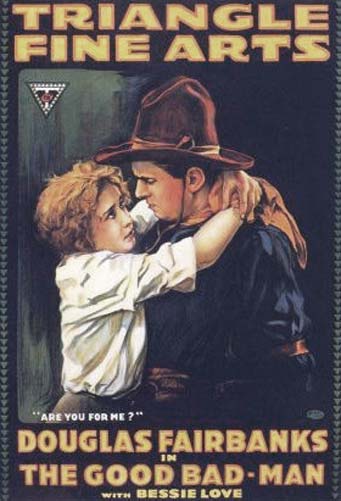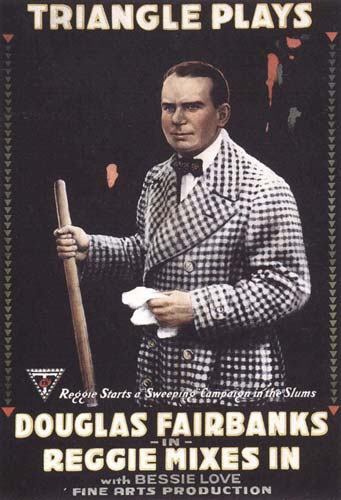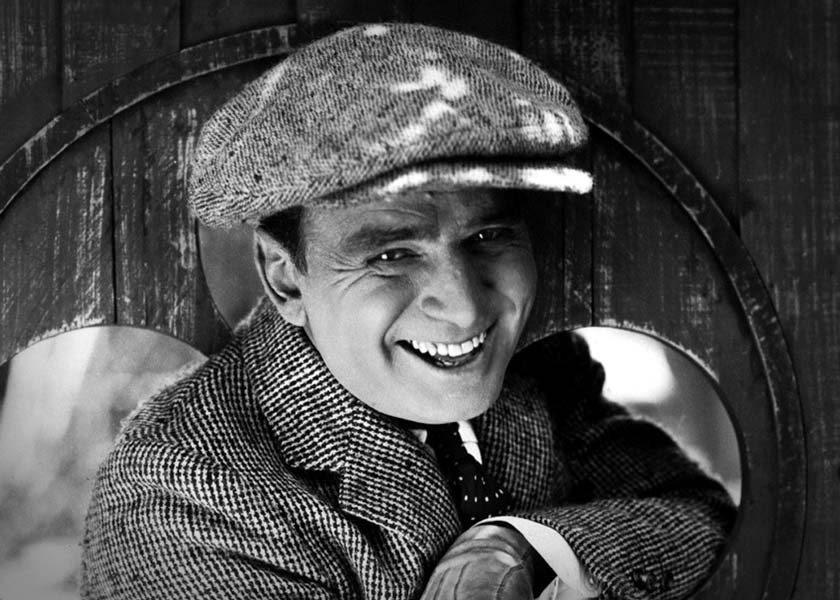The career of Douglas Fairbanks, superstar and film legend, began as feature film, at least five reels in length, became the dominant film form, superseding one and two-reelers. From his first film, The Lamb (1915), Fairbanks was a public favorite. Audiences responded enthusiastically to Fairbanks’s high-spirited and cheerful personality, his athleticism, and his humor-filled approach to storytelling.
Douglas Fairbanks' movie career began in 1915, shortly after the formation of the Triangle Motion Picture Company by Harry E. Aitken. Aitken had been involved in film production, distribution, and exhibition since 1910. In 1913, he had signed D. W. Griffith at his Majestic Studio. In 1914, Aitken provided financial backing for Griffith’s The Birth of a Nation, released to great success in 1915, earning Aitken a fortune on his investment. In July, 1915, Aitken used his earnings to create a new film production and releasing company, Triangle Motion Picture Company (also known as Triangle Film Corporation), in Los Angeles, California, with himself as president. Aitken and his associates at Triangle planned to engage a number of dramatic stars, produce prestigious feature films, and lease a chain of theaters in large US cities to showcase these films. The expansive plan included the formation of subsidiary companies in countries around the world.
The Triangle name derived from the subdivision of film production among the corporation’s three vice presidents: D. W. Griffith, Thomas H. Ince, and Mack Sennett. Each member of this trio, the art directors of the company, had his own studio lot where films were produced under his supervision. Griffith's studio, Fine Arts Film Company, was located on Sunset Boulevard in Los Angeles. Sennett's studio, Keystone Studios, and Ince's studio, Kay-Bee Company, were also located in the Los Angeles area.
Many actors who had made their names in the theater signed with Triangle, including Billie Burke, Mary Boland, DeWolf Hopper, Eddie Foy, Joe Weber and Lew Fields (of comedy double-act Weber and Fields), H.B. Warner, Dustin Farnum, W. S. Hart, House Peters, William Desmond, and Douglas Fairbanks.
Fairbanks careeer on Broadway had begun in 1902; by 1914 he was making $500 per week as a popular stage star, playing the active young American in a succession of plays written to suit his personality and athletic abilities. Unknown in films, Fairbanks signed with Triangle on June 26, 1915. He would be making films at Fine Arts Studio with an initial salary of $2000 per week with a $500 increase every six months. His contract stipulated that all films would be personally supervised by Griffith.
The Lamb
Fairbanks’ first film, The Lamb, was based on a play,
The New Henrietta (1913), that had been specially tailored for
Fairbanks and whose character in the play is named Bertie van Alstyne,
the Lamb.
Despite the stipulations in Fairbanks' contract,
The Lamb would be the only one of his Triangle-Fine Arts films
overseen, though not directed, by D.W. Griffith, who was preoccupied with his
complex epic Intolerance. The film premiered in New York on September
23, 1915, as part of a program of the first three feature films produced by the
Triangle Motion Picture Company. The Lamb came from Griffth’s studio.
The Iron Strain, starring Dustin Farnum and Enid Markey, was produced
by Kay-Bee, and My Valet, with Raymond Hitchcock and Mabel Normand,
was produced by Keystone. Despite the stipulations in Fairbanks' contract,
The Lamb would be the only one of his Triangle-Fine Arts films
overseen, though not directed, by D.W. Griffith, who was preoccupied with his
complex epic Intolerance.
The plot of The Lamb is similar to many of Fairbanks’ Triangle-Fine
Arts films: Gerald, the Lamb
, has never had to make his own living and is
soft. His fiancée believes him a coward and calls off the engagement.
Gerald goes into training with a prize fighter and a jui-jitsu wrestler to
make good
with his girl. He follows her to Arizona where they are kidnapped
by native Yaquis. Gerald escapes and holds off the kidnappers with a machine gun
until they are rescued by the calvary. Having proven himself, Gerald wins back his
bride.
Fairbanks was an immediate hit with critics and audiences, overshadowing the stars
of the other two films. Variety praised The Lamb as the
classiest kind of melodramatic comedy, wonderfully staged, brillantly acted,
humorously captioned…Douglas Fairbanks registers on screen as well as
anyone and more strongly than most.
Aitken and the senior producers at Triangle regarded The Lamb as so
good that they made Fairbanks a flattering proposition to foresake the legitimate
stage for several years and devote himself to films. Fairbanks, who had thoroughly
enjoyed the moviemaking experience and felt that plays constricted his
physicality, accepted. Whereas in a play he generally had only one scene during
which he could jump through a window, smash a few chairs, fight three men, and
come up smiling, in a film, with its wide open spaces and less restrictive plot
lines, he could ride, rope, climb trees, leap off balconies, have several fights,
and always come up smiling (throughout his career, the Fairbanks smile was noted
one of his greatest assets). He never returned to the theater.
Asked how he liked making movies following the release of The Lamb,
Fairbanks replied, They get me. I’m for them and for them strong.
Career at Triangle-Fine Arts
From his first film, Fairbanks was an overwhelming success with the public. Filmgoers were captivated by Fairbanks coming at them off the movie screen. In only a few months he became one of the most popular stars in the movies, and, by early 1917, his earning potential now estimated at one million dollars a year, he ranked with Charlie Chaplin and Mary Pickford at the top of audience popularity.
By the end of 1916, Fairbanks intended to break his long-term contract with the Triangle Motion Picture Company and form his own company. Fairbanks argued that the contract was already void because Griffith, preoccupied with production of Intolerance had not given his productions the personal attention that had been stipulated. He also stated that the film producers had violated the contract by assigning actresses to Fairbanks’ films in order to establish their names for value. Majestic Motion Picture Company (essentially an alternate name for Griffith’s Fine Arts Film Company) brought suit seeking to restrain Fairbanks from working for any other company. Before being brought to the Supreme Court of New York, the suit was settled by a monetary payment to Majestic, and Fairbanks was released from his contract. Simultaneously with the settlement of the suit, The Douglas Fairbanks Picture Company was organized, with Fairbanks as president, Beth Fairbanks, his wife, as vice president, and John Fairbanks, his brother, as treasurer.
The Films
From 1915-16, Fairbanks made twelve features (and one bizarre two-reeler) produced by Fine Arts Film Company and distributed by Triangle Motion Picture Company, mostly variations on the simple, straightforward plot of The Lamb: a young American, often initially ineffectual and callow, proves himself through manliness and physical exertion and wins the girl of his heart. These films, each made at a cost of approximately $40,000, have a runtime of five reels (50-60 minutes), the minimum for a feature-length film. Fairbanks frequently contributed to the stories, often working with his favorite collaborators, writer-director John Emerson and writer Anita Loos.
The Lamb, released November, 1915. Directed by Christy Cabanne.
Double Trouble, released December, 1915. Directed by Christy Cabanne.

His Picture in the Papers, released February, 1916. Directed by John Emerson. Fairbanks has multiple chances to display his athletic skills as he attempts to please his girl by getting his picture in the papers.
The Habit of Happiness, released March, 1916. Directed by Allan Dwan.
Sunny Wiggins (Fairbanks) takes down-and-outers into his rich home. His father
tells him to either stop bringing them home or to go live with them. So he moves
out and forms The Happiness Society
in a Bowery lodging house. He helps a
grouchy old man find happiness and marries the man’s daughter. His father relents
and accepts Doug’s family into his home.
The Good Bad-Man, released April, 1916. Directed by Allan Dwan. Story co-written by Fairbanks. Fairbanks plays a cheerful and aimless outlaw, named Passin' Through, who has an affinity for orphans because he was an orphan child and does not know his own parentage. Fearing he was illegitimate, Passin' Through clears up the mystery of his parentage and learns that they were married, allowing him to marry his sweetheart (Bessie Love). The film has the usual thrills and action, but playing an outlaw, even a not very bad one, was an unusual role for Fairbanks.
The Mystery of the Leaping Fish, released May, 1916. Directed John
Emerson. This two-reel burlesque, one of the strangest films made during the
silent era, stars Fairbanks as cocaine-addicted Sherlock Holmes parody
Coke Ennyday
, who is trying to prevent the smuggling of drugs inside rubber
fish (by using up the drugs himself). Not surprisingly, Fairbanks disliked the
film and wanted it withdrawn from distribution. Tod Browning, future director of
Dracula (1931) and Freaks (1932), wrote the story.

Reggie Mixes In, released June, 1916. Directed by Christy Cabanne. Reggie Morton (Fairbanks), a wealthy young idler, searches for adventure in the underworld. He meets Agnes (Bessie Love), who works in a seedy, dangerous club. He visits the club and, while there, beats up a ruffian and earns a job as the club’s bouncer. When a fight breaks out, he beats up a whole crowd of toughs. He is overjoyed when the girl, not knowing of his wealth, agrees to marry him, even if he is a lowly bouncer.
Flirting with Fate, releaed June, 1916. Directed by Christy Cabanne. A struggling artist, Augy Holliday (Fairbanks), wants to marry Gladys (Jewel Carmen), whose father intends to marry her to a rich man. Despondent, the artist hires an assassin to help him commit suicide. After inheriting money and learning that Gladys loves him after all, Augy now has to avoid the assassin. He saves himself and marries the girl.
The Half-Breed, released July, 1916. Directed by Allan Dwan, with
cinematography by Victor Fleming (director of Gone with the Wind).
Based on a novel, In the Carquinez Woods (1883), by Bret Harte.
Fairbanks plays an orphan half-breed, Lo Sleeping Water
Dorman, who lives
in a giant redwood tree. As a half-breed he is shunned by the racist white
population of the nearby town, whose sheriff, unbeknowst to Lo, is his father. A
Mexican dancer and outlaw (Alma Rubens) hides out
in his tree home. After a forest fire results in his father's death, Lo, now aware
of his father's identity, leaves to start again in a new place. The dancer follows
him, and there is a suggestion that they will get together.
The Half-Breed is the most serious of Fairbanks' Triangle-Fine Arts
films and provides him with an unusual role.
Manhattan Madness, released October, 1916. Directed by Allan Dwan.
American Aristocracy, released November, 1916. Directed by Lloyd Ingraham.
The Matrimaniac, released December, 1916. Directed by Paul Powell.
The Americano, released December, 1916. Directed by John Emerson. Cinematography by Victor Fleming. Fairbanks, in his last Triangle-Fine Arts film, plays Blaze Derringer, an American mining engineer working in Patagonia, a fictional country in South America. After falling in love with Juana de Castille (Alma Rubens), daughter of the deposed and imprisoned President of Patagonia, Blaze rescues the President, restores him to office, and marries Juana.
Dissolution of the Triangle Motion Picture Company
Triangle's alliance of the three production studios, Fine Arts, Keystone, and Kay-Bee, broke up in early 1917. Despite the success of Fairbanks and other actors, the high costs associated with film production at the three studios was not matched by the returns from the box office. Griffith left Triangle in March, 1917, and Ince and Sennett departed in June. The remnants of the Triangle Company continued to produce films until 1919 when the company ceased operations. Harry Aitken, who had invested his money in Triangle, lost most of his fortune. After Triangle ceased production, a financially reduced Aitken left the movie business and returned to his birthplace, Waukesha, Wisconsin, where he resided until his death in 1956.
Further Reading

